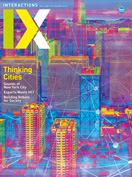Authors:
Eric Corbett, Daniela Rosner, Alex Taylor, Mikael Wiberg
The notion of "spatial" means relating to, occupying, or having the character of space. While the spatial dimensions of urban environments have always been subject to rapid reconfiguration, the extent to which digital technology can now drive spatial change is worth noting. Consider Burger King (Home of the Whopper), which recently revealed designs for restaurants that would be 100 percent touchless and 60 percent smaller than traditional restaurants. "Burger Kings of Tomorrow" will be able to deliver food straight from the kitchen to digital-coded pickup lockers mounted on the outside of the buildings. Perhaps the most novel of the designs is the "suspended kitchen," where the kitchen is built over the drive-through lanes (ideal for urban spaces). The suspended kitchen will allow customers to order from QR code menus and then have their food delivered to them from above via a conveyor belt system. Digital technologies no longer just bridge distances or occupy space. More radically, these technologies can potentially, and literally, reconfigure the grounds and the logics of our everyday lives.
What does it mean for digital infrastructure to transform the basic patterns of urban life, from food security to housing? How do place-based tools for payment, reviewing, mapping, and mutual aid shape existing experiences of displacement, segregation, and cultural resilience? Like digital burger lockers and suspended kitchens, the examples in this issue explore these questions. They look at the influx of social media with existing social infrastructure; they explore the role of digital tools in urban racial formations; and they chart the trade-offs of digital augmentation, place-based tracking, and digital repossession. But they also animate a claim HCI scholar Paul Dourish made almost 20 years ago: Introducing technology into spaces (in this case, the city) does not simply create new opportunities for sociality; rather, it transforms the opportunities for understanding the structure of those spaces.
What does it mean for digital infrastructure to transform the basic patterns of urban life, from food security to housing?
This issue of Interactions explores and critiques these technologically mediated transformations of city space. Graham Dove introduces novel machine learning techniques to enable urban residents to interact with sound, specifically noise pollution. Yanni Loukissas's hybrid mapmaking tools create new opportunities for reimagining relationships and histories of urban space. In dialogue with Eric Corbett, legal scholar of AI fairness and accountability Rashida Richardson anchors these provocations in an insightful analysis of how modern AI technologies can mediate segregation.
Together these contributions bring a rich reading of urban digital developments to everyday spaces—complicating a pervasive naturalization of social divisions, diversions, and absences. When designers and technologists approach today's cities, they require more than a problem-solving intuition. They need new frameworks for understanding the spatial as always tied to community, for grappling with competing interests and timelines, and for elevating the needs of those who have worked the hardest to maintain what they have all along. To grasp the changes and challenges of digital urbanism is not to believe in a technological promise—for example, the faster, denser, cleaner, safer suspended kitchen. It is to place those promises on a longer trajectory where an equitable footprint (social, environmental, infrastructural) might someday come to matter.
Eric Corbett (guest editor) [email protected]
Daniela Rosner, Alex Taylor, Mikael Wiberg [email protected]
Copyright held by authors
The Digital Library is published by the Association for Computing Machinery. Copyright © 2022 ACM, Inc.








Post Comment
No Comments Found